
Back HMS Safari (P211) German اچاماس سافاری (پی۲۱۱) Persian HMS Safari (P211) French HMS Safari (P211) Ukrainian
 Safari underway on the River Mersey
| |
| History | |
|---|---|
| Name | Safari |
| Ordered | 23 January 1940 |
| Builder | Cammell Laird, Birkenhead |
| Laid down | 5 June 1940 |
| Launched | 18 November 1941 |
| Commissioned | 14 March 1942 |
| Honours and awards | Sicily 1943, Mediterranean 1943 |
| Fate |
|
| Badge |  |
| General characteristics | |
| Class and type | S-class submarine |
| Displacement |
|
| Length | 217 ft (66.1 m) |
| Beam | 23 ft 9 in (7.2 m) |
| Draught | 14 ft 8 in (4.5 m) |
| Installed power |
|
| Propulsion |
|
| Speed |
|
| Range | 6,000 nmi (11,000 km; 6,900 mi) at 10 knots (19 km/h; 12 mph) (surfaced); 120 nmi (220 km; 140 mi) at 3 knots (5.6 km/h; 3.5 mph) (submerged) |
| Test depth | 300 ft (91.4 m) |
| Complement | 48 |
| Sensors and processing systems |
|
| Armament |
|
HMS Safari was a third batch S-class submarine built for the Royal Navy during World War II. Commissioned in 1942, she was assigned to operate in the Mediterranean Sea. During the course of the war, Safari sank twenty-five ships, most of which were Italian.[1]
Laid down on 5 June 1940 at Birkenhead, Safari was launched on 18 November 1941 and commissioned on 14 March 1942 at Holy Loch. Between May and August 1942, Safari patrolled in the west Mediterranean, based in Gibraltar. After two failed attempts to attack enemy ships during a first patrol in the Alboran Sea, Safari conducted a second patrol, sinking her first ship, the Italian merchant Adda. In her next patrol, she escorted the Allied convoy in Operation Pedestal, then sank two additional ships and damaged another. On 12 September, Safari was reassigned to the 10th Submarine Flotilla in Malta, with which she conducted two patrols in the Adriatic Sea, sinking one ship and damaging several more. Safari then operated off Sicily, evading an attack by German aircraft then sinking two ships. On 18 November, Safari fired a torpedo at ships anchored at Ras Ali, Libya; but the torpedo passed under, striking and wrecking the port's mole along a length of 25 metres (82 ft), killing five men.
Safari went on to sink five ships, then was assigned to the 8th Submarine Flotilla in Algiers. During a patrol off Naples, she was mistakenly bombed by British aircraft but was not damaged; Safari went on to sink four boats, then carried out special operations, landing men in Sicily, then later in Sardinia. After an attack by an Italian destroyer in which she was not damaged, Safari conducted two patrols during the Allied landings in North Africa, sinking four ships. Safari returned to England on 8 September 1943, and conducted training operations with the 7th Submarine Flotilla, punctuated by a short patrol off Norway to guard against a potential sortie to Germany of the German battleship Tirpitz.
After the end of World War II, Safari was placed in reserve, then sold for scrap on 7 January 1946. However, she sank off Portland the next day while being towed to the shipbreaking yard.